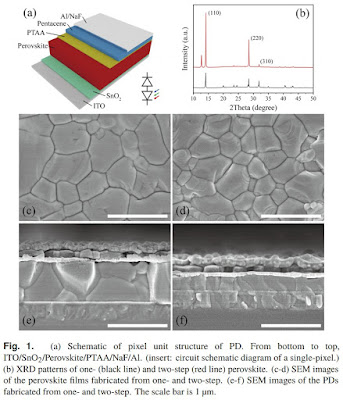The papers below promise to revolutionize future image sensor technology in many different ways. Whether you believe it or not is up to you.
OSA publishes Tianjin University, China, paper "
Low operating voltage monolithic stacked perovskite photodetectors for imaging applications" by Hongliang Zhao, Tengteng Li, Qingyan Li, Chengqi Ma, Jie Li, Chenglong Zheng, Yating Zhang, and Jianquan Yao.
"The monolithic stacked design is expected to solve the challenges of wiring difficulties, complex fabrication processes, and low resolution. However, a photodetector array with low operating voltage that is suitable for imaging applications has not been proposed. Here, a perovskite photodetector array with a monolithic stacked structure is proposed. The CH3NH3PbI3 photodetector has a low power consumption off-state (0 V) and on-state (−2 V) voltage, and the highest responsivity and specific detectivity of 0.39 A/W and 4.53e12 Jones at 775 nm, respectively. The rise time and decay time are 111 µs and 250 µs respectively. In addition, the imaging application shows high contrast, which provides a simple and effective way to prepare high performance perovskite imaging devices."


Science Magazine publishes North Carolina State University and KAIS paper "
Mantis shrimp–inspired organic photodetector for simultaneous hyperspectral and polarimetric imaging" by Ali Altaqui, Pratik Sen, Harry Schrickx, Jeromy Rech, Jin-Woo Lee, Michael Escuti, Wei You, Bumjoon J. Kim, Robert Kolbas, Brendan T. O’Connor, and Michael Kudenov.
"Combining hyperspectral and polarimetric imaging provides a powerful sensing modality with broad applications from astronomy to biology. Existing methods rely on temporal data acquisition or snapshot imaging of spatially separated detectors. These approaches incur fundamental artifacts that degrade imaging performance. To overcome these limitations, we present a stomatopod-inspired sensor capable of snapshot hyperspectral and polarization sensing in a single pixel. The design consists of stacking polarization-sensitive organic photovoltaics (P-OPVs) and polymer retarders. Multiple spectral and polarization channels are obtained by exploiting the P-OPVs’ anisotropic response and the retarders’ dispersion. We show that the design can sense 15 spectral channels over a 350-nanometer bandwidth. A detector is also experimentally demonstrated, which simultaneously registers four spectral channels and three polarization channels. The sensor showcases the myriad degrees of freedom offered by organic semiconductors that are not available in inorganics and heralds a fundamentally unexplored route for simultaneous spectral and polarimetric imaging."




"In summary, we employed a fundamental approach based on quantum master equations to identify the challenges in high performance photon number resolving photodetectors. A number of obstructions arise when attempting to achieve PNR (Photon Number Resolving) while simultaneously optimizing important metrics. Using our approach we are able to understand the reasons for these obstructions and formulate designs that circumvent them. As a result, we designed a novel detector architecture based on coherently and collectively interacting absorbing elements, energy transfer, and a continuous monitoring process, that is able to achieve PNR as well as excellent performance in terms of efficiency, dark counts, bandwidth, and count rate. The needed physical properties of this architecture suggest that molecular and nanoscale systems are prime candidates to realize new generations of photodetectors."


Applied Physics Letters publishes a paper "
Monolithic infrared silicon photonics: The rise of (Si)GeSn semiconductors" by O. Moutanabbir, S. Assali, X. Gong, E. O'Reilly, C. A. Broderick, B. Marzban, J. Witzens, W. Du, S-Q. Yu, A. Chelnokov, D. Buca, and D. Nam from École Polytechnique de Montréal, National University of Singapore, University College Cork, RWTH Aachen University, Wilkes University, University of Arkansas, University Grenoble Alpes, Peter Gruenberg Institute, and Nanyang Technological University.
"(Si)GeSn semiconductors are finally coming of age after a long gestation period. The demonstration of device-quality epi-layers and quantum-engineered heterostructures has meant that tunable all-group IV Si-integrated infrared photonics is now a real possibility. Notwithstanding the recent exciting developments in (Si)GeSn materials and devices, this family of semiconductors is still facing serious limitations that need to be addressed to enable reliable and scalable applications. The main outstanding challenges include the difficulty to grow high-crystalline quality layers and heterostructures at the desired content and lattice strain, preserve the material integrity during growth and throughout device processing steps, and control doping and defect density. Other challenges are related to the lack of optimized device designs and predictive theoretical models to evaluate and simulate the fundamental properties and performance of (Si)GeSn layers and heterostructures. This Perspective highlights key strategies to circumvent these hurdles and hopefully bring this material system to maturity to create far-reaching opportunities for Si-compatible infrared photodetectors, sensors, and emitters for applications in free-space communication, infrared harvesting, biological and chemical sensing, and thermal imaging."



